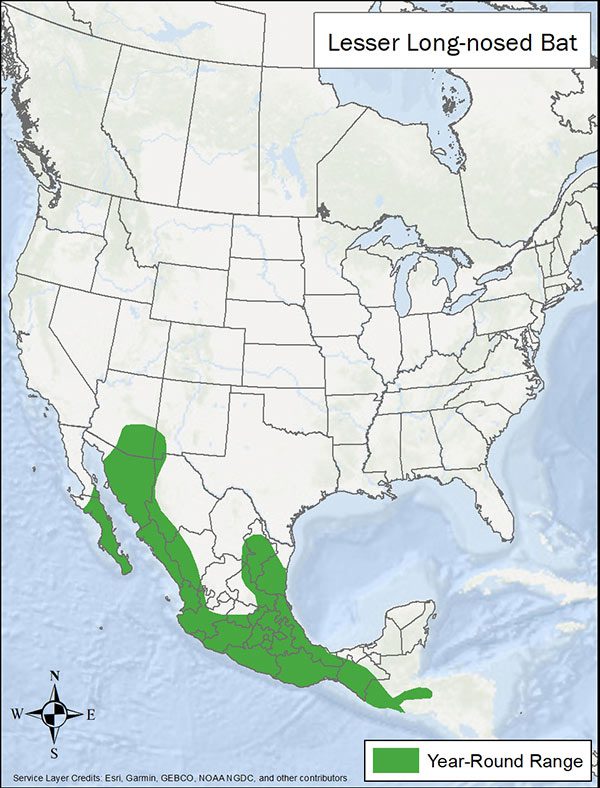LandPKS Learning
Habitat Hub

Lesser Long-nosed Bat
The lesser long-nosed bat pollinates saguaro, cardon, and organ pipe cactus and agave flowers. As the bat feeds on the nectar, the bat’s face and neck fur become covered with pollen. Lesser long-nosed bats also disperse the seeds of the columnar cacti fruits by feeding on them.
Leptonycteris yerbabuenae
Identification
The lesser long-nosed bat is a medium-sized migratory nectar bat approximately 3 in/8 cm in length with a wingspan of 10 in/25 cm and weighing approximately 0.8 oz/23 g. Being a nectar feeder, the lesser long-nosed bat’s tongue measures approximately the same length as its body. This long tongue provides access to nectar of deep desert flowers. Lesser long-nosed bats also have a small noseleaf, which is a fleshy leaf-shaped structure thought to be used for echolocation. This bat is yellow-brown or cinnamon gray in color and lives for about 12 years. The lesser long-nosed bat was listed by the United States and Mexico as Endangered until 2013 in Mexico and 2018 in the U.S. when it was assessed and determined to be no longer threatened.
Observation Tips
The lesser long-nosed bat is found in Arizona, New Mexico, much of Mexico including Baja, and into Central America. Being migratory, female bats move north following the blooming desert flowers in the spring. They spend summer months in the United States and northern Mexico moving south for the winter. Lesser long-nosed bats typically roost in caves and mines, as well as buildings, bridges, and trees. Males roost separately from females and babies. Many males stay in Mexico year-round.
Interesting Fact
The lesser long-nosed bat pollinates saguaro, cardon, and organ pipe cactus and agave flowers. As the bat feeds on the nectar, the bat’s face and neck fur become covered with pollen. Lesser long-nosed bats also disperse the seeds of the columnar cacti fruits by feeding on them.
Ideal Habitat
In the United States, lesser long-nosed bats live in desert scrub, desert grasslands, and Madrean oak woodlands that support agaves, saguaro and organ pipe cacti, and other flowering trees. In Mexico and Central America their preferred habitat is tropical deciduous forests and thorn forests. The lesser long-nosed bat feeds exclusively on the fruit and nectar of night-blooming cacti such as saguaro and organ pipe, and many species of agave. While they concentrate in roosts, their foraging habitat is very extensive.

Range map provided by International Union for Conservation of Nature
Management Activities that Benefit Species – Best Management Practices (BMPs)
Maintain night blooming cacti and agave distribution within desert scrub and desert grasslands.
Management Activities to Avoid
Avoid habitat loss through conversion to agriculture, urbanization, and destruction of habitat along the Mexico – U.S. border. Avoid harvesting of night blooming cacti and agave. Do not disturb bat roost sites, especially maternal colonies.
Other Species that Benefit from Similar Habitat Management
Management for lesser long-nosed bats protects the night blooming cacti such as saguaro and organ pipe cacti, and agave. Other species dependent upon these cacti and agave including Harris’s hawk, red-tailed hawk, Mexican long-tongued bat, white-throated woodrat, Gila woodpecker, gilded flicker, elf owl, screech owls, purple martin, and cactus wren.
Download
Download the Lesser Long-nosed Bat Factsheet
Other Resources
Bat Conservation International. Leptonycteris yerbabuenae
International Union for Conservation of Nature (IUCN). 2014. The IUCN Red List of Threatened Species. Version 2021-1 Leptonycteris yerbabuenae
NatureServe. 2021. NatureServe Explorer: An online encyclopedia of life [web application]. Version 7.1. NatureServe, Arlington, Virginia. Lesser long-nosed bat.
USFWS. Lesser long-nosed bat.
USFWS. Species profile. Lesser long-nosed bat
Photo credit: Alan Schmierer/Flickr
Mobile App | Data Portal | Knowledge Hub | Habitat Hub | Learning Collections | Blog | About | Contact | Support



